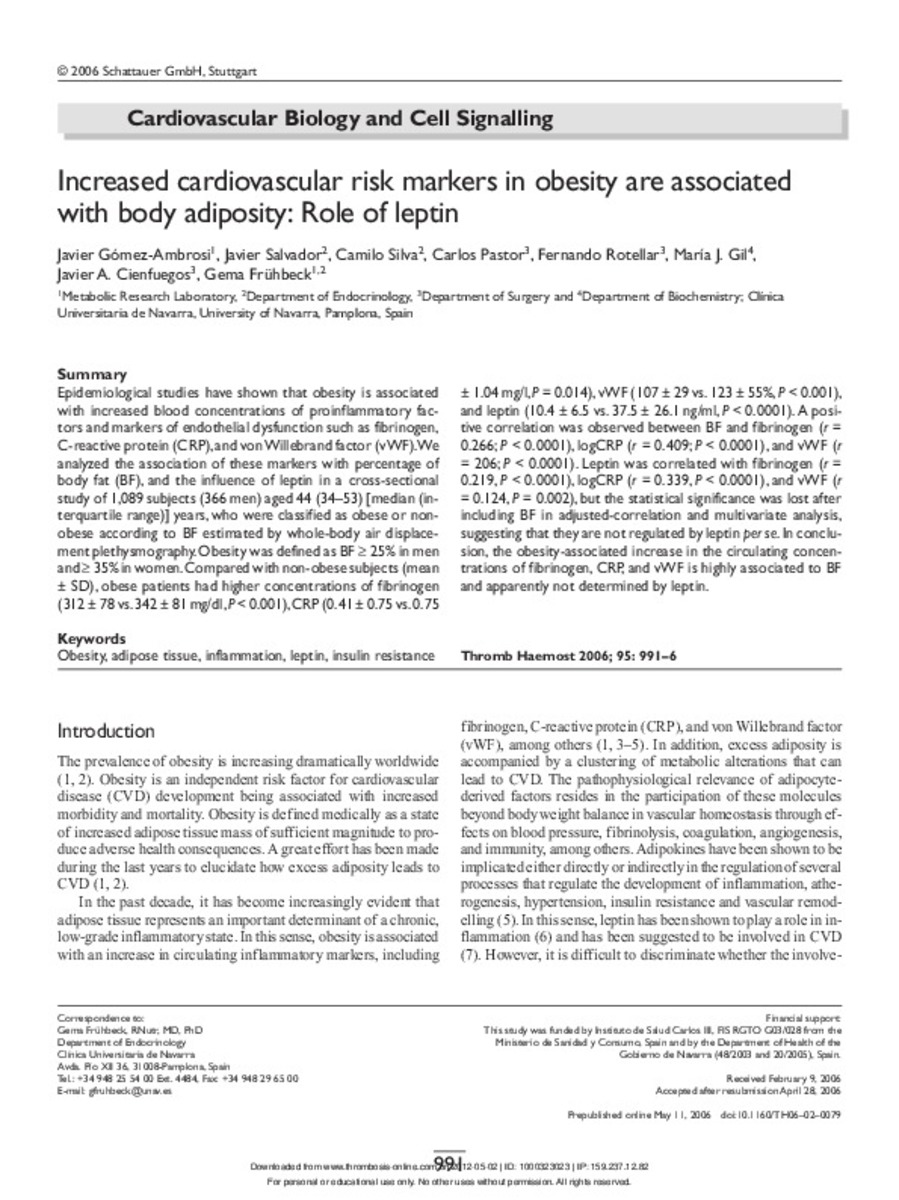Full metadata record
| DC Field | Value | Language |
|---|---|---|
| dc.creator | Gomez-Ambrosi, J. (Javier) | - |
| dc.creator | Salvador, J. (Javier) | - |
| dc.creator | Silva, C. (Camilo) | - |
| dc.creator | Pastor, C. (Carlos) | - |
| dc.creator | Rotellar, F. (Fernando) | - |
| dc.creator | Gil, M.J. (María José) | - |
| dc.creator | Álvarez-Cienfuegos, J. (Javier) | - |
| dc.creator | Frühbeck, G. (Gema) | - |
| dc.date.accessioned | 2012-05-02T14:35:32Z | - |
| dc.date.available | 2012-05-02T14:35:32Z | - |
| dc.date.issued | 2006 | - |
| dc.identifier.citation | Gomez-Ambrosi J, Salvador J, Silva C, Pastor C, Rotellar F, Gil MJ, et al. Increased cardiovascular risk markers in obesity are associated with body adiposity: role of leptin. Thromb Haemost 2006 Jun;95(6):991-996. | es_ES |
| dc.identifier.other | 0340-6245 | - |
| dc.identifier.uri | https://hdl.handle.net/10171/21877 | - |
| dc.description.abstract | Epidemiological studies have shown that obesity is associated with increased blood concentrations of proinflammatory factors and markers of endothelial dysfunction such as fibrinogen, C-reactive protein (CRP), and von Willebrand factor (vWF). We analyzed the association of these markers with percentage of body fat (BF), and the influence of leptin in a cross-sectional study of 1,089 subjects (366 men) aged 44 (34-53) [median (interquartile range)] years, who were classified as obese or nonobese according to BF estimated by whole-body air displacement plethysmography. Obesity was defined as BF >or= 25% in men and >or= 35% in women. Compared with non-obese subjects (mean +/- SD), obese patients had higher concentrations of fibrinogen (312 +/- 78 vs. 342 +/- 81 mg/dl, P < 0.001), CRP (0.41 +/- 0.75 vs. 0.75 +/- 1.04 mg/l, P = 0.014), vWF (107 +/- 29 vs. 123 +/- 55%, P < 0.001), and leptin (10.4 +/- 6.5 vs. 37.5 +/- 26.1 ng/ml, P < 0.0001). A positive correlation was observed between BF and fibrinogen (r = 0.266; P < 0.0001), logCRP (r = 0.409; P < 0.0001), and vWF (r = 206; P < 0.0001). Leptin was correlated with fibrinogen (r = 0.219, P < 0.0001), logCRP (r = 0., P < 0.0001), and vWF (r = 0.124, P = 0.002), but the statistical significance was lost after including BF in adjusted-correlation and multivariate analysis, suggesting that they are not regulated by leptin per se. In conclusion, the obesity-associated increase in the circulating concentrations of fibrinogen, CRP, and vWF is highly associated to BF and apparently not determined by leptin | es_ES |
| dc.language.iso | eng | es_ES |
| dc.publisher | Schattauer | es_ES |
| dc.rights | info:eu-repo/semantics/openAccess | es_ES |
| dc.subject | Obesity | es_ES |
| dc.subject | C-Reactive Protein/metabolism | es_ES |
| dc.subject | Cardiovascular Diseases/blood/etiology/metabolism | es_ES |
| dc.subject | Leptin/blood | es_ES |
| dc.title | Increased cardiovascular risk markers in obesity are associated with body adiposity: role of leptin | es_ES |
| dc.type | info:eu-repo/semantics/article | es_ES |
| dc.type.driver | info:eu-repo/semantics/article | es_ES |
| dc.identifier.doi | http://dx.doi.org/10.1160/TH06-02-0079 | es_ES |
Files in This Item:
Statistics and impact
Items in Dadun are protected by copyright, with all rights reserved, unless otherwise indicated.






